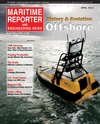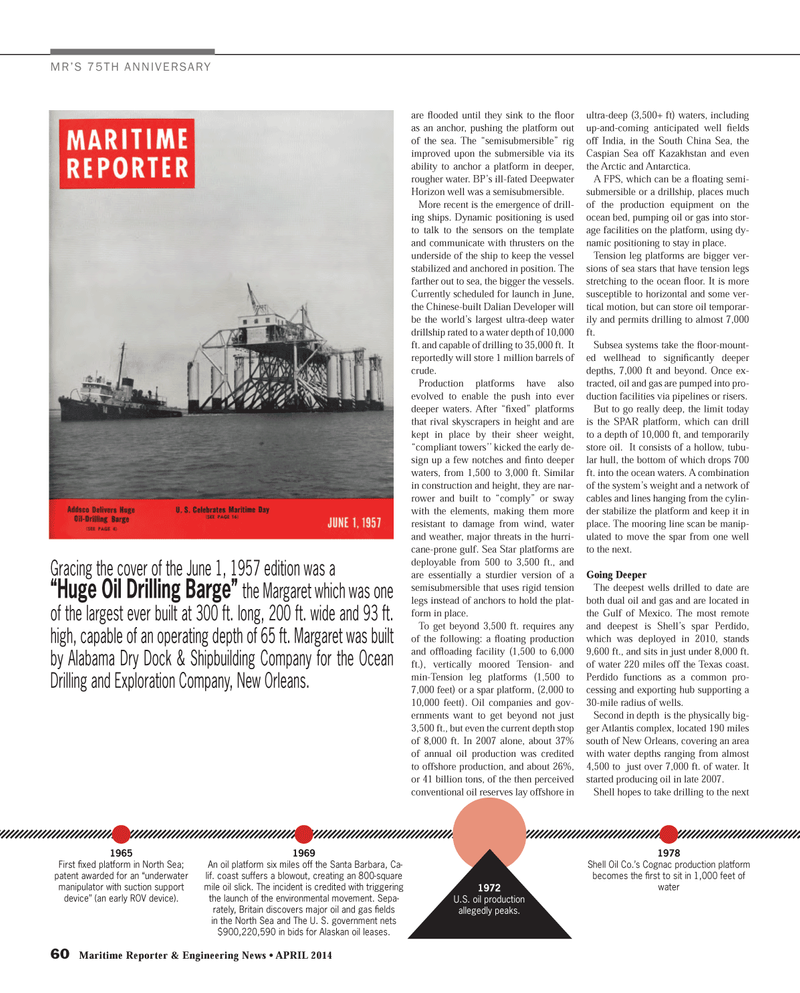
Page 60: of Maritime Reporter Magazine (April 2014)
Offshore Edition
Read this page in Pdf, Flash or Html5 edition of April 2014 Maritime Reporter Magazine
60 Maritime Reporter & Engineering News ? APRIL 2014 MR?S 75TH ANNIVERSARY are ß ooded until they sink to the ß oor as an anchor, pushing the platform out of the sea. The ?semisubmersible? rig improved upon the submersible via its ability to anchor a platform in deeper, rougher water. BP?s ill-fated Deepwater Horizon well was a semisubmersible.More recent is the emergence of drill- ing ships. Dynamic positioning is used to talk to the sensors on the template and communicate with thrusters on the underside of the ship to keep the vessel stabilized and anchored in position. The farther out to sea, the bigger the vessels. Currently scheduled for launch in June, the Chinese-built Dalian Developer will be the world?s largest ultra-deep water drillship rated to a water depth of 10,000 ft. and capable of drilling to 35,000 ft. It reportedly will store 1 million barrels of crude.Production platforms have also evolved to enable the push into ever deeper waters. After ? Þ xed? platforms that rival skyscrapers in height and are kept in place by their sheer weight, ?compliant towers?? kicked the early de- sign up a few notches and Þ nto deeper waters, from 1,500 to 3,000 ft. Similar in construction and height, they are nar- rower and built to ?comply? or sway with the elements, making them more resistant to damage from wind, water and weather, major threats in the hurri- cane-prone gulf. Sea Star platforms are deployable from 500 to 3,500 ft., and are essentially a sturdier version of a semisubmersible that uses rigid tension legs instead of anchors to hold the plat-form in place. To get beyond 3,500 ft. requires any of the following: a ß oating production and ofß oading facility (1,500 to 6,000 ft.), vertically moored Tension- and min-Tension leg platforms (1,500 to 7,000 feet) or a spar platform, (2,000 to 10,000 feett). Oil companies and gov-ernments want to get beyond not just 3,500 ft., but even the current depth stop of 8,000 ft. In 2007 alone, about 37% of annual oil production was credited to offshore production, and about 26%, or 41 billion tons, of the then perceived conventional oil reserves lay offshore in ultra-deep (3,500+ ft) waters, including up-and-coming anticipated well Þ elds off India, in the South China Sea, the Caspian Sea off Kazakhstan and even the Arctic and Antarctica. A FPS, which can be a ß oating semi- submersible or a drillship, places much of the production equipment on the ocean bed, pumping oil or gas into stor- age facilities on the platform, using dy-namic positioning to stay in place.Tension leg platforms are bigger ver- sions of sea stars that have tension legs stretching to the ocean ß oor. It is more susceptible to horizontal and some ver- tical motion, but can store oil temporar- ily and permits drilling to almost 7,000 ft. Subsea systems take the ß oor-mount- ed wellhead to signiÞ cantly deeper depths, 7,000 ft and beyond. Once ex-tracted, oil and gas are pumped into pro-duction facilities via pipelines or risers. But to go really deep, the limit today is the SPAR platform, which can drill to a depth of 10,000 ft, and temporarily store oil. It consists of a hollow, tubu- lar hull, the bottom of which drops 700 ft. into the ocean waters. A combination of the system?s weight and a network of cables and lines hanging from the cylin-der stabilize the platform and keep it in place. The mooring line scan be manip- ulated to move the spar from one well to the next.Going DeeperThe deepest wells drilled to date are both dual oil and gas and are located in the Gulf of Mexico. The most remote and deepest is Shell?s spar Perdido, which was deployed in 2010, stands 9,600 ft., and sits in just under 8,000 ft. of water 220 miles off the Texas coast. Perdido functions as a common pro-cessing and exporting hub supporting a 30-mile radius of wells. Second in depth is the physically big-ger Atlantis complex, located 190 miles south of New Orleans, covering an area with water depths ranging from almost 4,500 to just over 7,000 ft. of water. It started producing oil in late 2007. Shell hopes to take drilling to the next 1965First Þ xed platform in North Sea; patent awarded for an Òunderwater manipulator with suction support deviceÓ (an early ROV device). 1969 An oil platform six miles off the Santa Barbara, Ca- lif. coast suffers a blowout, creating an 800-square mile oil slick. The incident is credited with triggering the launch of the environmental movement. Sepa- rately, Britain discovers major oil and gas Þ elds in the North Sea and The U. S. government nets $900,220,590 in bids for Alaskan oil leases.1978Shell Oil Co.Õs Cognac production platform becomes the Þ rst to sit in 1,000 feet of waterGracing the cover of the June 1, 1957 edition was a ?Huge Oil Drilling Barge? the Margaret which was one of the largest ever built at 300 ft. long, 200 ft. wide and 93 ft. high, capable of an operating depth of 65 ft. Margaret was built by Alabama Dry Dock & Shipbuilding Company for the Ocean Drilling and Exploration Company, New Orleans. 1972 U.S. oil production allegedly peaks.MR #4 (56-65).indd 60MR #4 (56-65).indd 604/7/2014 3:14:27 PM4/7/2014 3:14:27 PM

 59
59

 61
61
